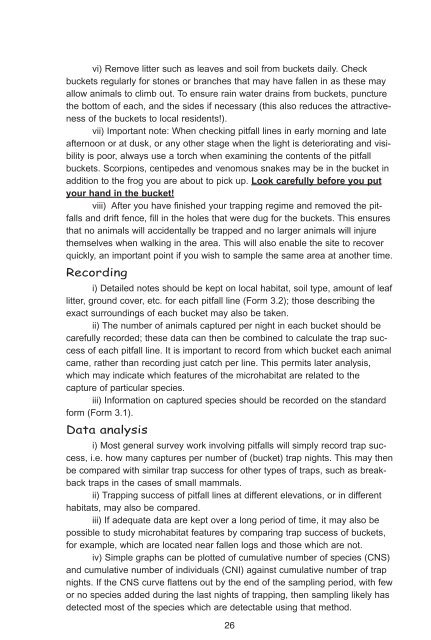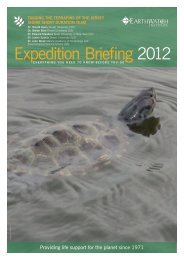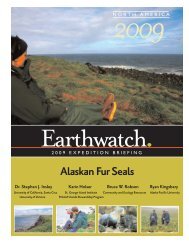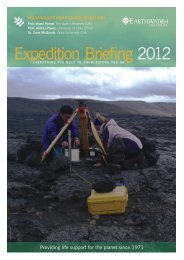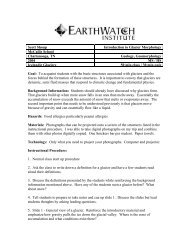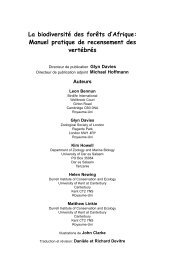African Forest Biodiversity - Earthwatch Institute
African Forest Biodiversity - Earthwatch Institute
African Forest Biodiversity - Earthwatch Institute
Create successful ePaper yourself
Turn your PDF publications into a flip-book with our unique Google optimized e-Paper software.
vi) Remove litter such as leaves and soil from buckets daily. Check<br />
buckets regularly for stones or branches that may have fallen in as these may<br />
allow animals to climb out. To ensure rain water drains from buckets, puncture<br />
the bottom of each, and the sides if necessary (this also reduces the attractiveness<br />
of the buckets to local residents!).<br />
vii) Important note: When checking pitfall lines in early morning and late<br />
afternoon or at dusk, or any other stage when the light is deteriorating and visibility<br />
is poor, always use a torch when examining the contents of the pitfall<br />
buckets. Scorpions, centipedes and venomous snakes may be in the bucket in<br />
addition to the frog you are about to pick up. Look carefully before you put<br />
your hand in the bucket!<br />
viii) After you have finished your trapping regime and removed the pitfalls<br />
and drift fence, fill in the holes that were dug for the buckets. This ensures<br />
that no animals will accidentally be trapped and no larger animals will injure<br />
themselves when walking in the area. This will also enable the site to recover<br />
quickly, an important point if you wish to sample the same area at another time.<br />
Recording<br />
i) Detailed notes should be kept on local habitat, soil type, amount of leaf<br />
litter, ground cover, etc. for each pitfall line (Form 3.2); those describing the<br />
exact surroundings of each bucket may also be taken.<br />
ii) The number of animals captured per night in each bucket should be<br />
carefully recorded; these data can then be combined to calculate the trap success<br />
of each pitfall line. It is important to record from which bucket each animal<br />
came, rather than recording just catch per line. This permits later analysis,<br />
which may indicate which features of the microhabitat are related to the<br />
capture of particular species.<br />
iii) Information on captured species should be recorded on the standard<br />
form (Form 3.1).<br />
Data analysis<br />
i) Most general survey work involving pitfalls will simply record trap success,<br />
i.e. how many captures per number of (bucket) trap nights. This may then<br />
be compared with similar trap success for other types of traps, such as breakback<br />
traps in the cases of small mammals.<br />
ii) Trapping success of pitfall lines at different elevations, or in different<br />
habitats, may also be compared.<br />
iii) If adequate data are kept over a long period of time, it may also be<br />
possible to study microhabitat features by comparing trap success of buckets,<br />
for example, which are located near fallen logs and those which are not.<br />
iv) Simple graphs can be plotted of cumulative number of species (CNS)<br />
and cumulative number of individuals (CNI) against cumulative number of trap<br />
nights. If the CNS curve flattens out by the end of the sampling period, with few<br />
or no species added during the last nights of trapping, then sampling likely has<br />
detected most of the species which are detectable using that method.<br />
26


